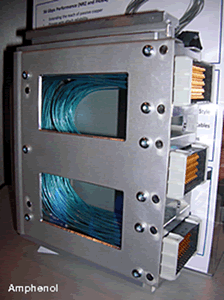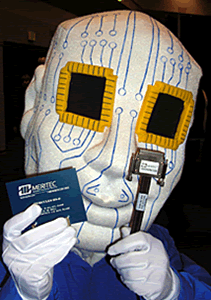DesignCon 2016 Technology Wrap-Up
DesignCon 2016 featured 33 interconnect manufacturers, all concentrating on ever-higher speeds and improved signal integrity.

DesignCon 2016 opened in the shadow of preparations for Super Bowl 50 at Levi’s Stadium, directly across the street from the Santa Clara Convention Center. With more than 160 exhibitors and 4,800 pre-registered attendees, the exposition and conference continues to grow each year. Connector and cable assembly suppliers have recognized the value of this expo and increased their participation with approximately 33 related manufacturers exhibiting this year, several with greatly expanded booths. The technical program remains a strong draw with more than 153 seminars, tutorials, and panel discussions arranged into 14 technology tracks.
Interconnect Trends
Several general interconnect trends emerged from multiple technical sessions as well as products on display:
- Although non-return-to-zero (NRZ) signaling remains dominant, interest in PAM-4 modulation is growing. The cost and complexity of long 28+Gb/s channels makes PAM-4 an attractive alternative to achieve next-generation data rates of 56Gb, 100Gb, and beyond without a forklift in technology. PAM-4 brings its own issues of cost, as well as reduced noise margin, increased power consumption, and challenges in test and modeling, but it continues to gain traction as evidenced by multiple technical sessions and product demonstrations.
- As system speeds increase, it is difficult to maintain adequate signal integrity using lower-cost printed circuit board laminate materials. High performance laminates are available but at a serious cost premium. An alternative is to take high-speed signals out of the board using shielded twin-ax copper cables. On-board cable jumpers can connect point-to-point or directly to the backplane or I/O interface. The cable backplane option is becoming an increasing popular way to eliminate all high-speed signals on a large backplane, greatly decreasing routing complexity, layer count, and cost while expanding reach. Several exhibitors demonstrated 56Gb/s NRZ channels through twin-axial cables to prove the advantages of twin-ax cable over PCB traces.
- Connector manufacturers continue to fine-tune their high-performance connector families by adding shields, tweaking plastic materials, and tightening manufacturing tolerances to minimize performance variations. Each of the major suppliers now offers a full plate of packaging options including standard, midplane, orthogonal, direct orthogonal, and cable backplane connector families. New complementary high-speed mezzanine connectors allow design engineers to package an entire system with one interconnect family.
- Demand for power continues to increase, as does concern for thermal management. Connector manufacturers are responding with expanded families of power connectors that tout higher current ratings achieved with improved copper alloy contacts and vented housings.
- The battle over increased input/output panel density is stimulating the creation of new connectors that enable more high-speed I/O in less space.
Technology Highlights at the Expo
Products displayed on the expo floor reflected these trends:
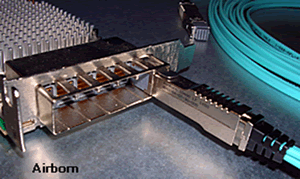 AirBorn showed the verSI interconnect, which is a high-density, open-pin-field, 1.27mm-pitch PCB and cable connector system that offers designers extreme flexibility in terms of pin assignment, pin count, and high-speed performance.
AirBorn showed the verSI interconnect, which is a high-density, open-pin-field, 1.27mm-pitch PCB and cable connector system that offers designers extreme flexibility in terms of pin assignment, pin count, and high-speed performance.
Its HD4 high-density cable-to-PCB interconnect can provide 60 10G ports that deliver 2400Gb/s in the same PCB edge space as 20 QSFP 10G ports that deliver 800Gb/s. Rugged four-point contact design ensures high reliability in harsh environments.
Amphenol showed its full array of high-speed and power connector systems including a cable backplane cassette that simplifies cable management issues. The XCede connector family has been upgraded to 56Gb via the new X2 configuration. The Paladin connector was used to demonstrate 56Gb/s NRZ performance over one meter of passive twin-ax cable. Also on display was the CoolPower product family, which comprised a full array of power connectors in card-edge, mezzanine, drawer, and backplane configurations.
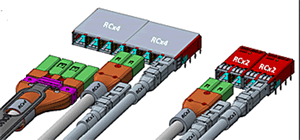
Amphenol has joined with Broadcom, Dell, and Hewlett Packard Enterprise in a new MSA to define a standard for short network cables. The RCx concept will feature low-cost 25Gb performance in a high-density profile that targets inter-rack applications of up to three meters.
The FCI booth was conveniently located adjacent to Amphenol, the company’s new owner. The process of coordination between products of both companies has begun. FCI demonstrated 100Gb/s serial signaling over 1.5 meters of single passive differential pair cable using duobinary signaling.
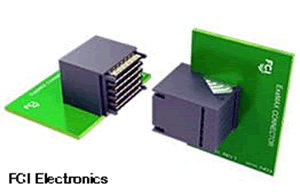 FCI also demonstrated 56Gb/s NRZ and PAM-4 signaling using its ExaMAX orthogonal direct connectors as well as an ExaMAX cable backplane running at 56Gb/s PAM-4 over two meters of cable.
FCI also demonstrated 56Gb/s NRZ and PAM-4 signaling using its ExaMAX orthogonal direct connectors as well as an ExaMAX cable backplane running at 56Gb/s PAM-4 over two meters of cable.
A display of power connectors addressed power densities of up to 300A per square inch. A variety of connectors conducting 120A in series demonstrated low loss and heat rise.
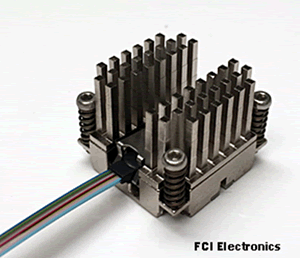
Given the interest in taking high-speed signals off the PCB, FCI showed a 12X25Gb/s, aggregate 300Gb/s link using its Leap optical mid-board transceiver.
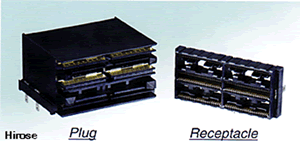 Hirose Electric USA continues to expand its extensive line of high-speed board-to-board connectors. It introduced the IT9 three- and four-row right-angle connectors rated to 28+Gb/s. Connectors with up to 224 contacts at 85Ω and 100Ω impedance are available. A mezzanine version of this connector will follow next year. Additionally, Hirose has been named as a second source to the Samtec FireFly optical flyover system.
Hirose Electric USA continues to expand its extensive line of high-speed board-to-board connectors. It introduced the IT9 three- and four-row right-angle connectors rated to 28+Gb/s. Connectors with up to 224 contacts at 85Ω and 100Ω impedance are available. A mezzanine version of this connector will follow next year. Additionally, Hirose has been named as a second source to the Samtec FireFly optical flyover system.
Meritec Hercules connector technology has been expanded into an HS-D Subminiature version sporting a rugged MIL-DTL-24308 shell. Available in 19-, 31-, 51-, 75-, and 108-position versions, this connector supports high-speed differential rates in excess of 10Gb/s with exceptional EMI/RFI isolation. PCB headers are surface-mounted. Custom length cable assemblies are also available.
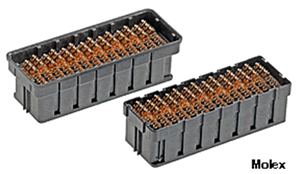 Molex introduced several new products including the NeoPress high-speed mezzanine connector. Using a unique mirror-image triad-contact layout to achieve data rates to 28Gb/s, this surface-mount stacking connector is available in 9mm and 45mm mated stack heights.
Molex introduced several new products including the NeoPress high-speed mezzanine connector. Using a unique mirror-image triad-contact layout to achieve data rates to 28Gb/s, this surface-mount stacking connector is available in 9mm and 45mm mated stack heights.
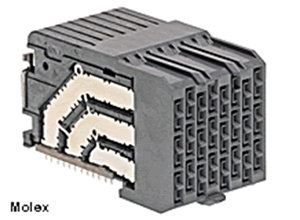 The latest iteration of the Impel backplane connector family is the Impel Plus with performance upgraded to 56Gb/s. Refinements include additional grounding tail aligners, smaller compliant pins, and optimized signal contact geometry.
The latest iteration of the Impel backplane connector family is the Impel Plus with performance upgraded to 56Gb/s. Refinements include additional grounding tail aligners, smaller compliant pins, and optimized signal contact geometry.
Live demonstrations included 56Gb/s NRZ over three meters of cable, 56Gb/s PAM-4 over 2.5 meters of cable, and 56Gb/s NRZ over .5 meters of hybrid backplane and a NeoPress mezzanine connector running at 32Gb/s NRZ.
The enlarged Samtec booth featured the ExaMAX high-speed backplane connector as an integral part of its end-to-end system packaging solution which includes advanced interconnect design, signal integrity analysis, high-speed cables, microelectronic packaging, and optical products.
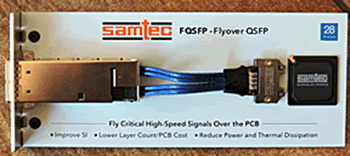 Its new FQSFP Flyover connector supports efforts to move high-speed signals from the board to twin-axial cable. Rather than standard QSFP I/O connectors typically terminated to the board, this design connects directly to shielded cable, which can “fly over” the board and terminate adjacent to an active device. Separable or press-fit connectors can be used at the far end of the cable. Signal integrity is improved by eliminating lossy PCB materials from the channel. Designers are free to locate devices without severe trace length restrictions.
Its new FQSFP Flyover connector supports efforts to move high-speed signals from the board to twin-axial cable. Rather than standard QSFP I/O connectors typically terminated to the board, this design connects directly to shielded cable, which can “fly over” the board and terminate adjacent to an active device. Separable or press-fit connectors can be used at the far end of the cable. Signal integrity is improved by eliminating lossy PCB materials from the channel. Designers are free to locate devices without severe trace length restrictions.
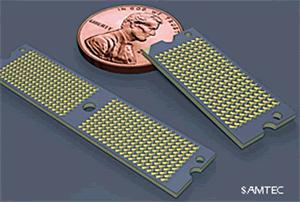 The Samtec booth featured its Z-Ray ultra-low-profile, high-speed board-to-board interposer with up to 400 contacts on 0.8mm or 1.0mm pitch.
The Samtec booth featured its Z-Ray ultra-low-profile, high-speed board-to-board interposer with up to 400 contacts on 0.8mm or 1.0mm pitch.
Samtec also demonstrated 28Gb/s signaling through 100 meters of OM3 fiber without the use of clock data recovery techniques.
TE Connectivity introduced the new microQSFP module and cage in the latest effort to increase signal density on the I/O panel. A supporting MSA includes leading suppliers of networking and interconnect products.
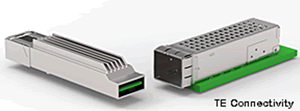 Roughly the size of the SFP form factor, the micro QSFP provides up to 4X28GB/s performance. The 33% density improvement allows designers to fit up to 72 ports on a standard 1RU line card.
Roughly the size of the SFP form factor, the micro QSFP provides up to 4X28GB/s performance. The 33% density improvement allows designers to fit up to 72 ports on a standard 1RU line card.
TE also introduced a new differential pair cable-to-PCB connector that supports above-the-board internal jumpering. The low-cost Sliver connector is rated to 25Gb/s with contacts on 0.6mm centerlines. A robust latch ensures reliable connection. Sliver connectors can be used in chip-to-I/O, backplane, and board-to-board links.
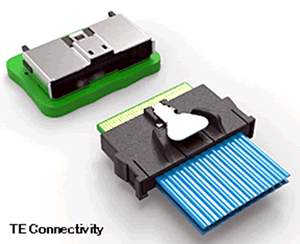 The performance of the TE Flagship STRADA Whisper high-speed backplane connector system has also been bumped up to 56Gb/s and is available in direct-plug orthogonal, mezzanine, and cable configurations.
The performance of the TE Flagship STRADA Whisper high-speed backplane connector system has also been bumped up to 56Gb/s and is available in direct-plug orthogonal, mezzanine, and cable configurations.
Live demonstrations included 72 microQSFP modules on a line card drawing only 5W each with very low and consistent temperatures across the matrix, an optic microQSFP module running at 100Gb/s NRZ, and a four-meter STRADA Whisper cable backplane running at 50Gb/s PAM-4.
Yamaichi has built a business around its extensive line of pluggable optical connector assemblies for applications in telecom infrastructure. Its products include CFP, CFP2, CFP4, and QSFP28/56 connectors as well as passive and active copper cable assemblies. This year Yamaichi is the first to introduce the CFP8 connector, which is compliant with the CFP8 MSA guideline. This connector supports 400Gb Ethernet over 16 channels operating at 25GBaud rates. Single- and dual-port configurations are available.
DesignCon continues to be the premiere showcase of innovative chip, board, and interconnect technology that will enable the next generations of high-speed products.
- Optics Outpace Copper at OFC 2024 - April 16, 2024
- Digital Lighting Enhances your Theatrical Experience - March 5, 2024
- DesignCon 2024 in Review - February 13, 2024
